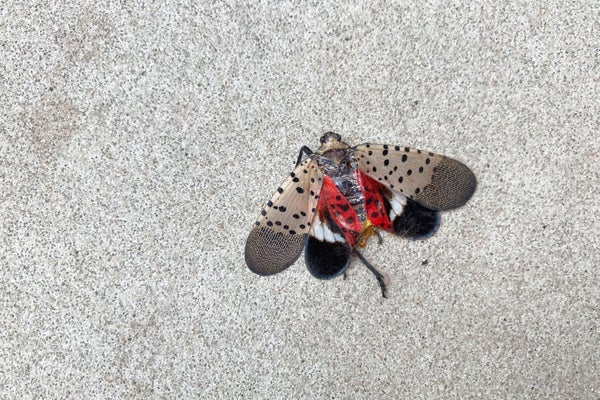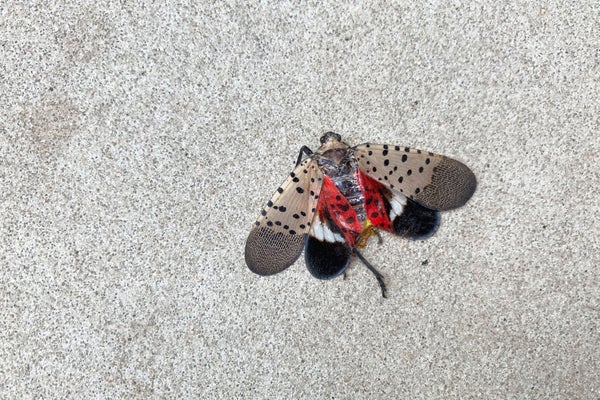
September 18, 2024
4 min read
Has Stomping on Spotted Lanternflies Slowed Their Invasion?
Invasive spotted lanternflies are spreading across the metro areas of New York City, Philadelphia and Washington, D.C., despite professional and amateur attempts to reduce their numbers

A squashed spotted lanternfly in the Hudson Yards neighborhood in New York City.
Richard Levine / Alamy Stock Photo
Even the most hardened dweller of New York City’s concrete jungle was bound to notice when, suddenly, spotted lanternflies were everywhere.
It doesn’t take an experienced entomologist to notice the insects, which at every stage sport eye-catching polka dots and reach about one inch long in adulthood. Spotted lanternflies (Lycorma delicatula) originally hail from Asia, and their first documented appearance in the U.S. occurred in Pennsylvania in 2014. In the intervening decade, they have spread throughout New Jersey and Delaware and have made substantial inroads in New York State, Connecticut, Maryland and beyond. A spotted lanternfly infestation was first seen in New York City in 2020, and the insects quickly spread across the metropolis. Particularly large populations were seen there in 2022 and 2023.
“Just like so many invasive species, when they’re out of their native range, they don’t have the natural predators to keep them in check; the populations can explode,” says Brian Eshenaur, a plant pathologist at Cornell University, who works on New York State’s spotted lanternfly response. “That certainly has happened here.”
On supporting science journalism
If you’re enjoying this article, consider supporting our award-winning journalism by subscribing. By purchasing a subscription you are helping to ensure the future of impactful stories about the discoveries and ideas shaping our world today.
But this year the plague seems to have thinned in New York City—albeit only anecdotally, Eshenaur says. “We don’t have any real numbers to put with that,” he says. The New York State Department of Agriculture and Markets concurs, reporting that it has received fewer calls from city residents about spotted lanternflies.
Since the insects first appeared in the city, New Yorkers have heeded calls to squish the invasive species, and the vigilante justice may well have played a role in this year’s decline, both Eshenaur and entomologist Matthew Travis agree.
But when it comes to invasive species, one season of reduced sightings doesn’t merit a victory lap. “We know that they’re around. They haven’t left. They’re still here, and they’re still a concern,” says Jessica Ware, an entomologist at the American Museum of Natural History in New York City. She adds that spotted lanternfly populations seem distinctively patchy, with herds of the insects moving around, although scientists aren’t yet sure what drives the pattern. “That can give people the false idea that perhaps they’ve gone away,” she says.
And a stunning population boom followed by some declines is a pretty typical pattern for an invasive species, says Travis, who is national policy manager for spotted lanternflies at the U.S. Department of Agriculture’s Animal and Plant Health Inspection Service. Ware also notes several natural factors may have made it more difficult for spotted lanternflies to thrive in New York City this summer. “We did have a particularly dry summer, and the temperatures were particularly high,” she says. And Eshenaur cites reports that people have seen spotted lanternflies eaten by birds such as Northern Cardinals and Blue Jays and by insects such as praying mantises and wheel bugs.
That’s not to say that New Yorkers can’t claim credit for pounding the pavement in response to the invasion—or that there isn’t more work to be done. Travis says continuing to squash lanternflies, even in areas where they’re established, is helpful.
Even more important, however, is making sure not to carry the insects—or their eggs—from their current range into new territory. Spotted lanternflies can spread on their own wing power, Travis says, but the real issues come when humans give them a ride. “It’s not so much natural spread that we see as it is these large jumps,” he says. “This thing has become very adept and very good at hitchhiking.” He’s especially concerned about the way the insect’s spread seems to have followed railroads. To avoid giving spotted lanternflies a lift, people should carefully check their cars and cargo for adult insects or their nondescript egg cases, which look like splatters of dried mud.
Down the line, humans may have extra help in the fight against spotted lanternflies. In addition to the natural predation that Eshenaur says has begun, scientists are evaluating a host of potential lanternfly enemies. One fungus that is native to the mid-Atlantic seems to infect lanternflies on its own, he says, and scientists may be able to develop it into a commercially viable management tool. Researchers are also evaluating parasites that infect spotted lanternflies in their native range, testing for any risk that they could harm U.S. species if they were released here.
Meanwhile Ware wants people across the region, but especially in New York City, to take their experience with spotted lanternflies and carry it into the future—because there’s no chance the polka-dotted interloper will be the last new insect to arrive in town. “The spotted lanternfly is not necessarily super unique; we always get invasive species,” Ware says. “As long as people have traveled to North America, we have brought insects with us.”
That means it’s important to pay attention to the insects in your area and to keep your eyes peeled for newcomers—even those more subtle than spotted lanternflies—and to sound the alarm if you see something six-legged and suspicious, Ware says. “If you see something that you’re not used to seeing in your neighborhood,” she adds, “you should let somebody know.”
Source link




